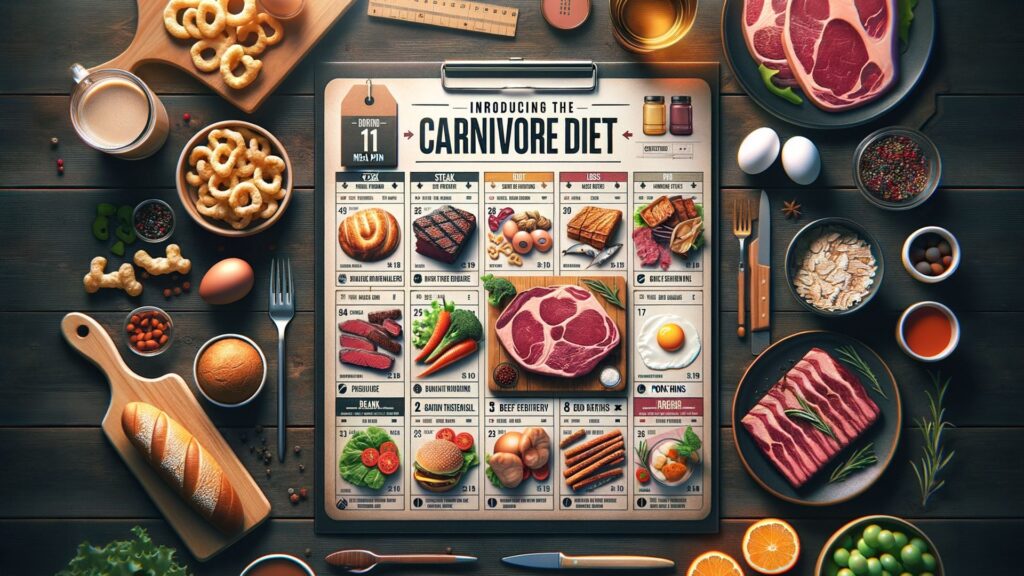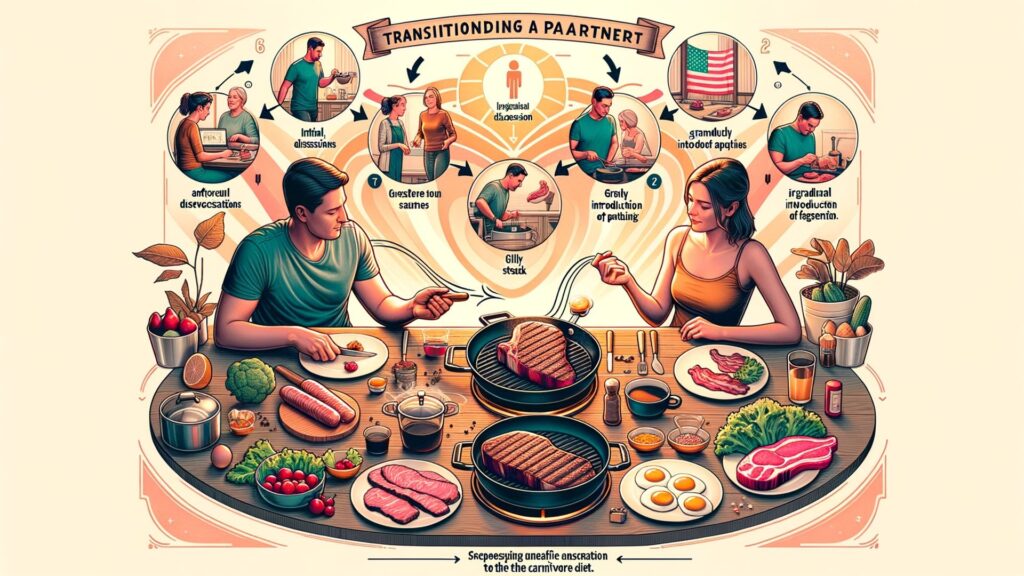Introducing the Carnivore Diet to Your Partner: Meal Plan and Carnivore Snax
The Carnivore Diet, often described as a strict meat-only regimen, offers a unique approach to nutrition that emphasizes animal products while eliminating virtually all plant foods. If you are considering introducing this diet to your partner, understanding its fundamentals and benefits can facilitate a smooth transition. This article will help you navigate the intricacies of the carnivore lifestyle, including meal planning, nutritious snacks, and how to address common concerns.

What is the Carnivore Diet and How Does It Work?
Understanding the Basics of the Carnivore Diet
The carnivore diet is an elimination diet that primarily consists of animal products, including various types of meat, seafood, eggs, and dairy products. This way of eating is characterized by its simplicity and focuses on high consumption of animal protein and fat while entirely avoiding carbohydrates and plant-based foods. The diet’s framework allows for a range of animal-derived food sources, including organ meat, which is nutrient-dense and packed with vitamins and minerals. By adhering to this diet, individuals aim to reduce inflammation, enhance satiety, and improve overall health through a minimalistic approach to food intake.
How Does the Carnivore Diet Differ from Keto?
While both the carnivore diet and the ketogenic (keto) diet are low-carb, they differ significantly in their food choices and overall philosophy. The keto diet allows for a limited intake of carbohydrates, often incorporating low-carb vegetables and healthy fats such as avocado, nuts, and seeds. In contrast, the carnivore diet strictly eliminates all plant foods, focusing solely on animal-based products. While the keto diet may allow for some flexibility in food selection, the carnivore diet emphasizes a more rigid adherence to meat and animal fat, which can lead to a more profound metabolic shift for some dieters.
Benefits of Following a Carnivore Diet
Advocates of the carnivore diet often highlight several benefits, including weight loss, improved energy levels, and reduced autoimmune symptoms. The absence of carbohydrates can lead to significant fat loss as the body enters a state of ketosis, where it burns fat for fuel instead of glucose. This metabolic state can enhance mental clarity and physical performance for some individuals. Additionally, the carnivore diet may promote gut health by reducing inflammatory responses associated with certain plant-based foods. By focusing on nutrient-dense animal products, dieters can also obtain essential vitamins and minerals, including vitamin C, magnesium, and other micronutrients crucial for optimal health.
How to Create a Carnivore Diet Meal Plan
Essential Components of a Carnivore Diet Meal Plan
A well-structured carnivore diet meal plan should prioritize a variety of meat options, including beef, pork, chicken, and seafood. Incorporating organ meats is also vital, as they provide a concentrated source of nutrients often lacking in muscle meat. Animal fat should be a core component, as it enhances flavor and promotes satiety. Additionally, incorporating dairy products can provide further nutritional benefits, although some individuals may choose a strict carnivore diet that excludes all dairy. Planning meals around these essential components will create a balanced and satisfying dietary regimen.

Sample Carnivore Diet Meal Plan for Beginners
For those new to the carnivore diet, a sample meal plan could include breakfast options like scrambled eggs cooked in butter or bacon strips. For lunch, one might enjoy a grilled steak accompanied by a side of bone marrow. Dinner could consist of roasted chicken thighs paired with a rich, creamy sauce made from animal fat. Snacks can include beef jerky or deviled eggs, ensuring that the need for between-meal nourishment is met without straying from the diet’s principles. This sample carnivore diet meal plan demonstrates the variety available while sticking to an animal-based approach.
Tips for Meal Prep on a Modified Carnivore Diet
Meal prep can be a game-changer for those following a modified carnivore diet, allowing for convenience and consistency. To streamline the process, consider batch cooking larger quantities of meat and portioning them for easy access throughout the week. Utilizing a slow cooker or pressure cooker can also yield tender, flavorful meats with minimal effort. Having a selection of carnivore snax on hand, such as hard-boiled eggs or pork rinds, can aid in maintaining adherence to the diet while satisfying cravings. Consistency in meal preparation not only simplifies dietary adherence but fosters a more enjoyable carnivore diet experience.
What Are the Best Carnivore Snax for Your Diet?
Nutritious Carnivore Snax You Can Make at Home
Creating your own carnivore snax at home is both satisfying and nutritious. Options include homemade beef jerky, which can be seasoned to taste and dehydrated for a convenient on-the-go snack. Another delightful option is crispy pork belly bites, which can be seasoned and baked to perfection. Hard-boiled eggs are also an excellent snack choice, rich in protein and healthy fats. These homemade carnivore snax provide the nourishment required while adhering strictly to the principles of the carnivore diet.
Store-Bought Carnivore Snax: What to Look For
When selecting store-bought carnivore snax, it’s essential to look for products that contain minimal ingredients and avoid processed meats laden with preservatives. High-quality beef jerky, pork rinds, and meat sticks are excellent choices, provided they are made from grass-fed animals and free from added sugars or artificial flavors. Understanding the ingredient list will ensure that the snacks align with the carnivore diet’s goals and maintain a focus on nutrient density.
Incorporating Snacks into Your Carnivore Diet
Incorporating carnivore snax into your meal plan can enhance satisfaction and make the dietary transition smoother. Snacks can be particularly helpful for those experiencing cravings or for individuals who find themselves in social situations where food options are limited. By planning for these occasions, dieters can avoid reaching for processed foods and maintain their commitment to the carnivore approach. Ensuring that snacks are nutrient-dense and in line with dietary goals will ultimately support long-term adherence and success.
How to Transition Your Partner to the Carnivore Diet
Communicating the Benefits of the Carnivore Diet
When introducing the carnivore diet to your partner, clear communication about its benefits is crucial. Discuss the potential improvements in health, energy levels, and weight management that many carnivore dieters experience. Highlighting personal testimonials and scientific research supporting the advantages of a meat-based diet can help alleviate concerns and misconceptions regarding dietary choices. Fostering an open dialogue about the carnivore diet may encourage your partner to consider its unique approach to nutrition.

Overcoming Common Objections to Following a Carnivore
Common objections to adopting the carnivore diet often stem from concerns about nutrient deficiencies or the exclusion of plant foods. Addressing these concerns with factual information about the nutrient density of animal products can help ease apprehension. Explain that the carnivore diet is designed to provide essential vitamins and minerals found predominantly in animal-based foods, such as fatty fish, red meat, and organ meats. Additionally, discussing the elimination of inflammatory foods often found in plant-based diets may help underscore the diet’s health benefits.
Gradual Transition Strategies to a Meat-Based Diet
For those apprehensive about making a sudden shift to a strict carnivore diet, a gradual transition may be more appealing. Start by reducing carbohydrate intake and incorporating more animal-based meals into the existing diet, gradually phasing out plant foods. This approach allows the body to adapt while minimizing potential withdrawal symptoms associated with cutting out carbohydrates. By taking small, manageable steps, your partner may find the transition to a carnivore lifestyle to be more comfortable and sustainable.
What Nutritional Considerations Should You Keep in Mind?
Vitamins and Minerals in a Carnivore Diet
Understanding the vitamins and minerals provided by a carnivore diet is essential for ensuring adequate nutrition. Animal products are rich in numerous essential nutrients, including B vitamins, iron, zinc, and omega-3 fatty acids. However, one must also be cognizant of certain vitamins, such as vitamin C, which is less prevalent in animal products. It’s crucial to plan meals that incorporate a variety of meats and organ meats to ensure a diverse nutrient intake, supporting overall health while following a carnivore diet.
Addressing Concerns About Nutrient Deficiencies
Concerns regarding nutrient deficiencies on the carnivore diet can be addressed through careful meal planning and education. By emphasizing the importance of including organ meats, seafood, and different cuts of meat, dieters can ensure they are receiving a broad spectrum of nutrients. Moreover, understanding the body’s unique adaptation to a low-carb, high-fat diet can provide reassurance that many individuals thrive on a carnivore diet without experiencing deficiencies.
How to Ensure Adequate Fat Intake on a Carnivore Diet
Ensuring adequate fat intake on the carnivore diet is vital for maintaining energy levels and promoting satiety. The diet emphasizes the consumption of animal fat, which can be incorporated through fatty cuts of meat, bone marrow, and cooking with tallow or lard. By prioritizing high-fat animal products, dieters can achieve the necessary caloric intake while enjoying the benefits of a meat-based approach. Monitoring fat intake is crucial, as it plays a significant role in the overall success of the carnivore diet.
Introduce The Carnivore Diet To Your Partner Frequently Asked Questions:
Q: What is the carnivore diet?
A: The carnivore diet is a restrictive diet that involves eating only animal foods, primarily meat and animal fat. Proponents of the diet argue that it can lead to various health benefits while eliminating carbs and plant-based foods.
Q: How can I introduce the carnivore diet to my partner?
A: To introduce the carnivore diet to your partner, start by discussing its principles and benefits. You might suggest preparing meals together that align with the all-meat diet, highlighting delicious recipes that emphasize meat and animal fat.
Q: What does a typical meal plan look like on the carnivore diet?
A: A typical meal plan on the carnivore diet consists of various cuts of meat, organ meats, and animal fats. This can include ribeye steaks, ground beef, eggs, and bone broth, along with snacks such as beef jerky or pork rinds.
Q: Are there any snacks that fit the carnivore diet?
A: Yes, carnivore dieters consider snacks like beef jerky, pork rinds, and hard-boiled eggs as suitable options. These snacks provide protein and fat without the inclusion of carbs.
Q: Can the carnivore diet help with health issues like rheumatoid arthritis?
A: Some proponents of the diet claim that following the carnivore diet may alleviate symptoms of autoimmune disorders, including rheumatoid arthritis. However, results may vary, and it’s advisable to consult a healthcare professional before making dietary changes.
Q: How does the carnivore diet compare to the ketogenic diet?
A: The carnivore diet is more restrictive than the ketogenic diet as it excludes all plant-based foods and emphasizes an animal-based diet. While the keto diet allows for low-carb vegetables and specific fruits, the carnivore diet focuses solely on meat and animal fat.
Q: What are the potential benefits of following the carnivore diet?
A: Potential benefits of following the carnivore diet may include weight loss, improved mental clarity, and reduced inflammation. Additionally, the diet encourages the consumption of rich sources of nutrients found in animal foods, which some individuals find beneficial.
Q: What adjustments to your diet might be necessary when starting the carnivore diet?
A: When starting the carnivore diet, adjustments may include gradually eliminating carbs and transitioning from a standard American diet to an all-meat diet. It’s important to listen to your body and make dietary changes that suit your individual needs.
Q: Is intermittent fasting compatible with the carnivore diet?
A: Yes, intermittent fasting can be practiced alongside the carnivore diet. Many adherents find that combining these approaches helps to manage hunger and optimize fat utilization from the high meat intake.




